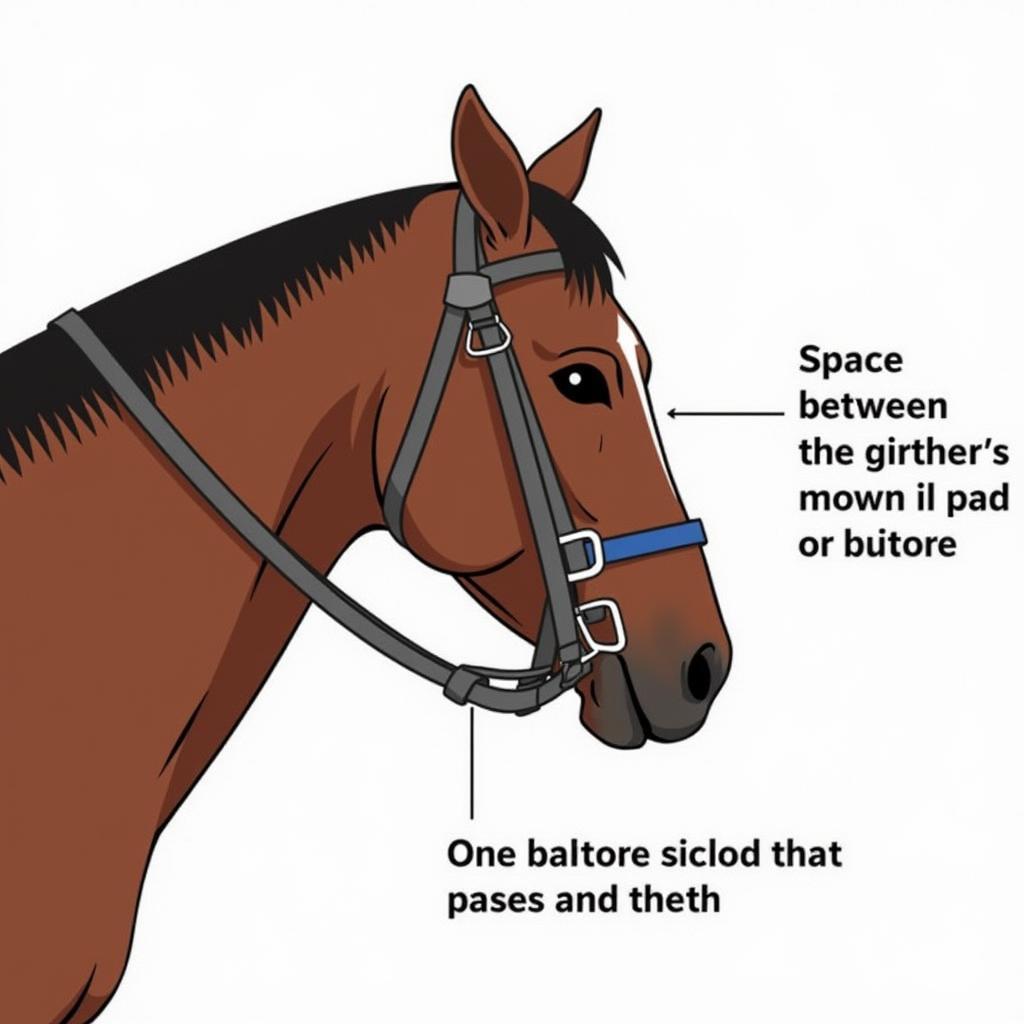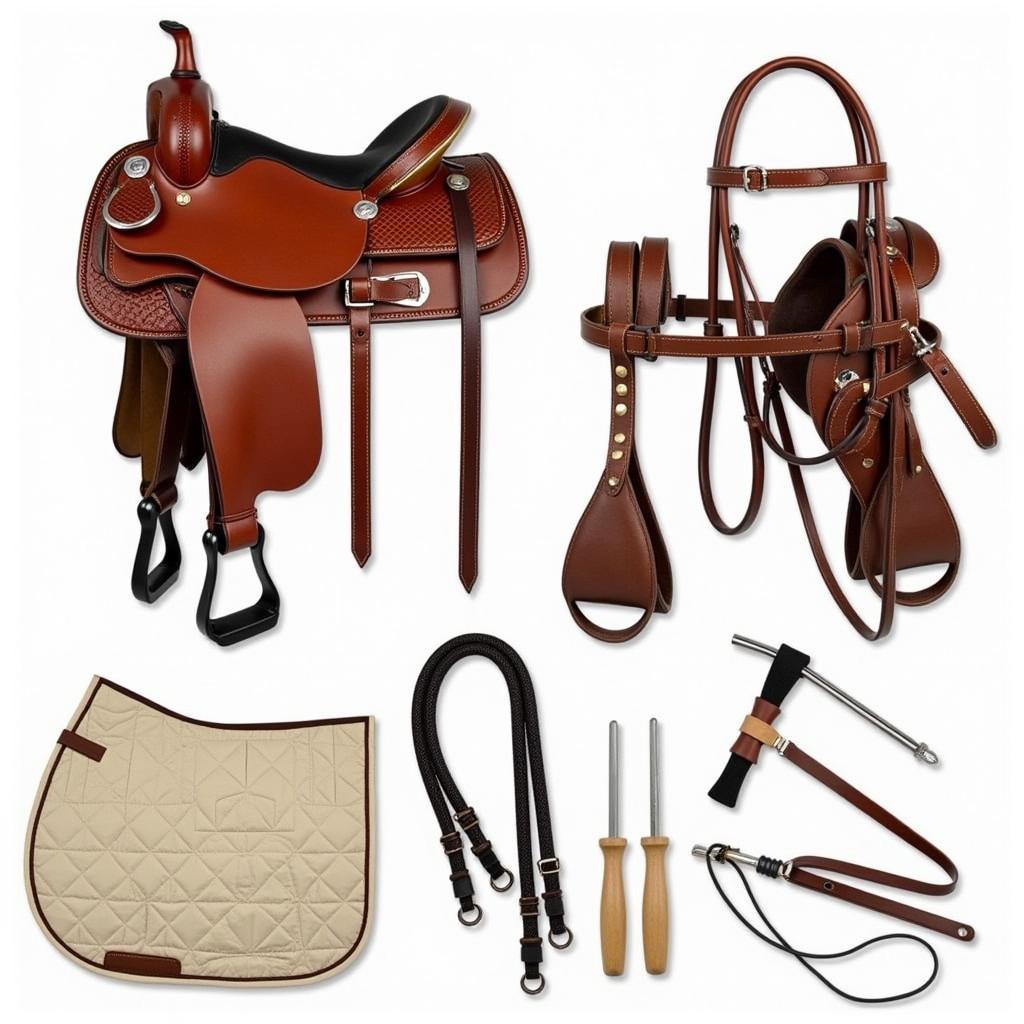Horse Strapping, the art of correctly fitting and adjusting tack, is crucial for both horse and rider comfort and safety. Improper strapping can lead to pressure points, sores, and even behavioral issues in horses, while also compromising the rider’s security and control. This guide will delve into the intricacies of horse strapping, providing you with the knowledge and skills to ensure a comfortable and safe riding experience.
Understanding the Importance of Correct Horse Strapping
Why is horse strapping so vital? It’s the foundation of a harmonious relationship between horse and rider. Correctly fitted tack distributes pressure evenly, preventing discomfort and promoting freedom of movement. This allows the horse to perform at its best and reduces the risk of injuries. For the rider, proper strapping translates to a secure and balanced seat, enhancing control and communication with the horse.
Key Considerations Before You Begin
Before you even touch a strap, there are some crucial factors to keep in mind. Firstly, know your horse’s anatomy. Understanding where sensitive areas lie will guide you in fitting the tack correctly. Secondly, consider the type of riding you will be doing. Different disciplines require specific tack adjustments. Finally, always prioritize your horse’s comfort. If something doesn’t seem right, adjust it until it does.
Step-by-Step Guide to Strapping Your Horse
Now, let’s walk through the strapping process step by step.
- The Saddle Pad: Position the saddle pad correctly on the horse’s withers, ensuring it sits comfortably and doesn’t slip.
- The Saddle: Gently place the saddle on top of the pad, ensuring it’s centered and balanced. Check for even weight distribution.
- The Girth: Fasten the girth, starting loosely and gradually tightening. Avoid over-tightening, which can restrict breathing and cause discomfort.
- The Bridle: Fit the bridle carefully, ensuring the bit sits comfortably in the horse’s mouth. Adjust the cheekpieces and throatlatch so they are snug but not restrictive.
- Final Checks: Before mounting, perform final checks to ensure all straps are secure and the tack fits comfortably.
 Correctly Adjusted Girth and Bridle
Correctly Adjusted Girth and Bridle
Common Strapping Mistakes and How to Avoid Them
Even experienced riders can make mistakes when strapping. Over-tightening the girth is a common error, restricting the horse’s breathing. Another mistake is failing to check the saddle fit regularly, which can lead to pressure sores. Always double-check your work and prioritize your horse’s comfort.
“Remember, consistent and correct strapping is not just about avoiding injuries. It builds trust and strengthens the bond between horse and rider,” says renowned equine expert, Dr. Emily Carter, DVM.
Essential Equipment for Horse Strapping
Having the right equipment makes strapping easier and more efficient. A well-fitting saddle and bridle are essential, along with a comfortable saddle pad. A grooming kit can also be helpful for cleaning the horse and the tack.
Maintaining Your Tack
Proper tack maintenance is crucial for longevity and safety. Regularly clean and condition your leather tack to prevent cracking and wear. Store your tack in a dry, well-ventilated area to prevent mold and mildew.
“Investing in high-quality tack and maintaining it diligently will pay off in the long run, ensuring both your horse’s comfort and your own peace of mind,” adds Dr. Carter.
 Essential Horse Strapping Equipment
Essential Horse Strapping Equipment
Conclusion
Mastering horse strapping is an essential skill for any rider. By following the steps outlined in this guide and prioritizing your horse’s comfort, you can ensure a safe and enjoyable riding experience. Remember, correct horse strapping is the foundation for a strong partnership between horse and rider.
FAQ
- How tight should the girth be? You should be able to fit two fingers comfortably between the girth and the horse’s elbow.
- How often should I check the saddle fit? Check the saddle fit before each ride, and have it professionally checked annually.
- What are the signs of an ill-fitting saddle? Signs include resistance, unusual behavior, and sores under the saddle area.
- How can I tell if the bridle is too tight? The bridle is too tight if it’s restricting the horse’s breathing or causing discomfort.
- What type of saddle pad is best? The best type of saddle pad depends on the horse’s conformation and the type of riding you’re doing.
- How do I clean my leather tack? Use a damp sponge and saddle soap to clean leather tack, followed by a leather conditioner.
- How should I store my tack? Store your tack in a cool, dry, and well-ventilated area.
Common Scenarios and Questions:
Scenario: Your horse seems uncomfortable after being strapped.
Question: What should I do?
Answer: Check the tack for any pressure points or areas of discomfort. Adjust the tack as needed, and consult with a professional if the problem persists.
Scenario: You are unsure about the correct placement of the saddle.
Question: Where should the saddle sit?
Answer: The saddle should sit comfortably on the horse’s back, just behind the withers, and not interfere with the shoulder blades.
Further Reading:
- Horseback Riding Safety Tips
- Choosing the Right Saddle for Your Horse
- Understanding Horse Anatomy
Need further assistance? Contact us at Phone Number: 0772127271, Email: [email protected] or visit us at QGM2+WX2, Vị Trung, Vị Thuỷ, Hậu Giang, Việt Nam. We have a 24/7 customer service team.